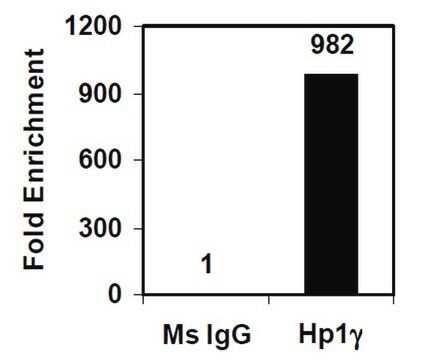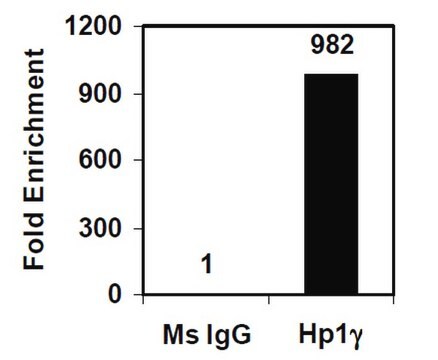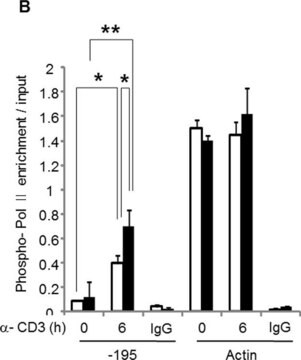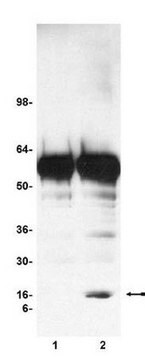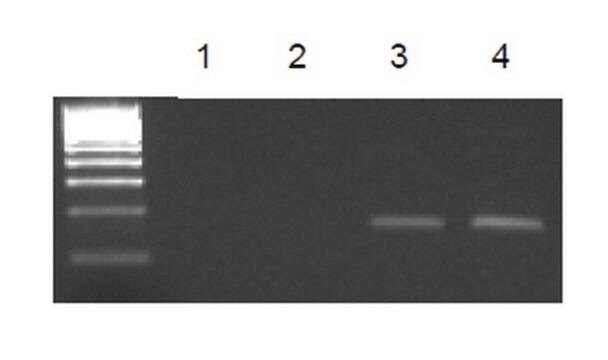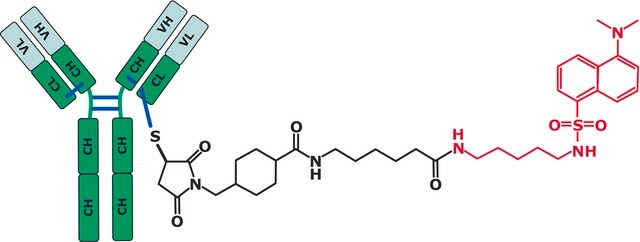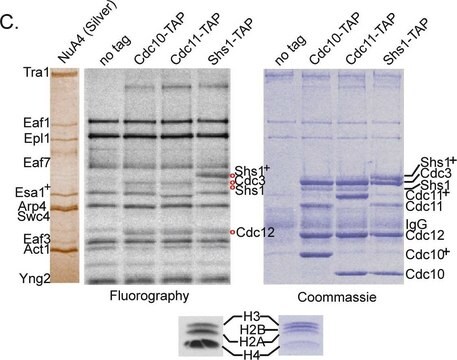17-10046
ChIPAb+ Histone H3 (CT) - przeciwciało z walidacją ChIP i zestaw primerów, królicze monoklonalne
culture supernatant, from rabbit
Synonim(y):
H3, histon H3, rodzina histonów H3, członek T, histon 3, H3, klaster histonów 3, H3
About This Item
Polecane produkty
pochodzenie biologiczne
rabbit
Poziom jakości
forma przeciwciała
culture supernatant
klon
monoclonal
reaktywność gatunkowa
Saccharomyces cerevisiae, rat, human, chicken, mouse, yeast
producent / nazwa handlowa
ChIPAb+
Upstate®
metody
ChIP: suitable
dot blot: suitable
immunoprecipitation (IP): suitable
western blot: suitable
izotyp
IgG
numer dostępu NCBI
numer dostępu UniProt
Warunki transportu
dry ice
Opis ogólny
Zestaw ChIPAb+ Histone H3 (C-term) zawiera przeciwciało Histone H3 (C-term), supernatant kontroli negatywnej (królik) i startery qPCR, które amplifikują region 110 bp ludzkiej β-globiny. Histone H3 (C-term) i kontrole negatywne są dostarczane w skalowalnym rozmiarze reakcji "per ChIP" i mogą być wykorzystane do funkcjonalnej walidacji wytrącania chromatyny związanej z Histone H3.
Specyficzność
Immunogen
Zastosowanie
Sonikowaną chromatynę przygotowaną z komórek HeLa (1 X106 równoważników komórek na IP) poddano immunoprecypitacji chromatyny przy użyciu 4 µL supernatantu kontroli negatywnej lub 4 µL anty-histonu H3 (C-termin) i zestawu Magna ChIP® A (nr kat. 17-610).
Pomyślna immunoprecypitacja fragmentów DNA związanych z histonem H3 została zweryfikowana przez qPCR przy użyciu starterów ChIP, β-globiny oraz starterów promotora GAPDH. (Patrz rysunki). Dane przedstawiono jako procentowy wkład każdej próbki IP w stosunku do chromatyny wejściowej dla każdego amplikonu i próbki ChIP, jak wskazano.
Szczegółowe informacje dotyczące eksperymentu można znaleźć w protokole EZ-Magna ChIP A (nr kat. 17-408) lub EZ-ChIP (nr kat. 17-371).
Analiza Western Blot:
Reprezentatywne dane partii.
Ekstrakty kwasów z komórek HeLa poddanych działaniu kolcemidu rozdzielono za pomocą elektroforezy, przeniesiono na nitrocelulozę i wysondowano anty-Histone H3 (C-term) (rozcieńczenie 1:1000).
Białka wizualizowano przy użyciu koziego przeciwciała drugorzędowego przeciw królikowi sprzężonego z HRP i systemu detekcji chemiluminescencji. (Patrz rysunki).
Analiza Western Blot:
Reprezentatywne dane partii.
Białka ekstrahowane kwasem z komórek HeLa nietraktowanych (Lane 1), traktowanych kolcemidem (Lane 2). Ekstrakty jądrowe HeLa (Lane 3), komórki HeLa ekstrahowane kwasem traktowane maślanem sodu (Lane 4), nietraktowane (Lane 5) i niemodyfikowany rekombinowany histon H3 (Lane 6) zostały rozdzielone za pomocą elektroforezy, przeniesione na nitrocelulozę i sondowane poprzednią partią anty-Histone H3 (C-term) (rozcieńczenie 1:5000).
Białka wizualizowano przy użyciu koziego przeciwciała drugorzędowego przeciw królikowi sprzężonego z HRP i systemu detekcji chemiluminescencji. (Patrz rysunki).
Epigenetics & Nuclear Function
Histones
Opakowanie
Jakość
Sonicated chromatin prepared from HeLa cells (1 X 106 cell equivalents per IP) were subjected to chromatin immunoprecipitation using 4 µL of either Negative Control Supernatant or 4 µL of Anti-Histone H3 (C-term) and the Magna ChIP® A Kit (Cat. # 17-610). Successful immunoprecipitation of Histone H3 associated DNA fragments was verified by qPCR using ChIP Primers, β-Globin (Please see figures).
Please refer to the EZ-Magna ChIP A (Cat. # 17-408) or EZ-ChIP (Cat. # 17-371) protocol for experimental details.
Opis wartości docelowych
Postać fizyczna
Supernatant kontroli negatywnej (królik). Jedna fiolka zawierająca 100 µL supernatantu hodowli w 0,05% azydku sodu. Przechowywać w temperaturze -20°C.
Primery ChIP, β-Globina.
Jedna fiolka zawierająca 75 μL po 5 μM każdego primera specyficznego dla ludzkiej β-globiny. Przechowywać w temperaturze -20°C.
FOR: AGG ACA GGT ACG GCT GTC ATC
REV: TTT ATG CCC AGC CCT GGC TC
Przechowywanie i stabilność
Komentarz do analizy
Zawiera supernatant kontroli ujemnej (królik) i startery specyficzne dla ludzkiej β-globiny.
Informacje prawne
Oświadczenie o zrzeczeniu się odpowiedzialności
Kod klasy składowania
10 - Combustible liquids
Certyfikaty analizy (CoA)
Poszukaj Certyfikaty analizy (CoA), wpisując numer partii/serii produktów. Numery serii i partii można znaleźć na etykiecie produktu po słowach „seria” lub „partia”.
Masz już ten produkt?
Dokumenty związane z niedawno zakupionymi produktami zostały zamieszczone w Bibliotece dokumentów.
Nasz zespół naukowców ma doświadczenie we wszystkich obszarach badań, w tym w naukach przyrodniczych, materiałoznawstwie, syntezie chemicznej, chromatografii, analityce i wielu innych dziedzinach.
Skontaktuj się z zespołem ds. pomocy technicznej